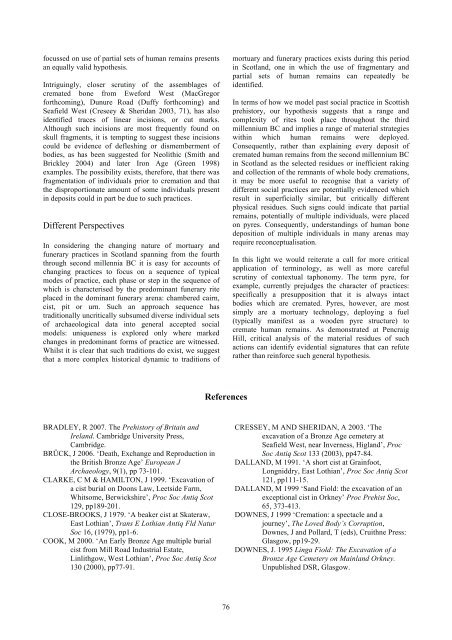The Materiality of Death - mikroarkeologi.se
The Materiality of Death - mikroarkeologi.se
The Materiality of Death - mikroarkeologi.se
Create successful ePaper yourself
Turn your PDF publications into a flip-book with our unique Google optimized e-Paper software.
focus<strong>se</strong>d on u<strong>se</strong> <strong>of</strong> partial <strong>se</strong>ts <strong>of</strong> human remains pre<strong>se</strong>nts<br />
an equally valid hypothesis.<br />
Intriguingly, clo<strong>se</strong>r scrutiny <strong>of</strong> the as<strong>se</strong>mblages <strong>of</strong><br />
cremated bone from Eweford West (MacGregor<br />
forthcoming), Dunure Road (Duffy forthcoming) and<br />
Seafield West (Cre<strong>se</strong>ey & Sheridan 2003, 71), has also<br />
identified traces <strong>of</strong> linear incisions, or cut marks.<br />
Although such incisions are most frequently found on<br />
skull fragments, it is tempting to suggest the<strong>se</strong> incisions<br />
could be evidence <strong>of</strong> defleshing or dismemberment <strong>of</strong><br />
bodies, as has been suggested for Neolithic (Smith and<br />
Brickley 2004) and later Iron Age (Green 1998)<br />
examples. <strong>The</strong> possibility exists, therefore, that there was<br />
fragmentation <strong>of</strong> individuals prior to cremation and that<br />
the disproportionate amount <strong>of</strong> some individuals pre<strong>se</strong>nt<br />
in deposits could in part be due to such practices.<br />
Different Perspectives<br />
In considering the changing nature <strong>of</strong> mortuary and<br />
funerary practices in Scotland spanning from the fourth<br />
through <strong>se</strong>cond millennia BC it is easy for accounts <strong>of</strong><br />
changing practices to focus on a <strong>se</strong>quence <strong>of</strong> typical<br />
modes <strong>of</strong> practice, each pha<strong>se</strong> or step in the <strong>se</strong>quence <strong>of</strong><br />
which is characteri<strong>se</strong>d by the predominant funerary rite<br />
placed in the dominant funerary arena: chambered cairn,<br />
cist, pit or urn. Such an approach <strong>se</strong>quence has<br />
traditionally uncritically subsumed diver<strong>se</strong> individual <strong>se</strong>ts<br />
<strong>of</strong> archaeological data into general accepted social<br />
models: uniqueness is explored only where marked<br />
changes in predominant forms <strong>of</strong> practice are witnes<strong>se</strong>d.<br />
Whilst it is clear that such traditions do exist, we suggest<br />
that a more complex historical dynamic to traditions <strong>of</strong><br />
mortuary and funerary practices exists during this period<br />
in Scotland, one in which the u<strong>se</strong> <strong>of</strong> fragmentary and<br />
partial <strong>se</strong>ts <strong>of</strong> human remains can repeatedly be<br />
identified.<br />
In terms <strong>of</strong> how we model past social practice in Scottish<br />
prehistory, our hypothesis suggests that a range and<br />
complexity <strong>of</strong> rites took place throughout the third<br />
millennium BC and implies a range <strong>of</strong> material strategies<br />
within which human remains were deployed.<br />
Con<strong>se</strong>quently, rather than explaining every deposit <strong>of</strong><br />
cremated human remains from the <strong>se</strong>cond millennium BC<br />
in Scotland as the <strong>se</strong>lected residues or inefficient raking<br />
and collection <strong>of</strong> the remnants <strong>of</strong> whole body cremations,<br />
it may be more u<strong>se</strong>ful to recogni<strong>se</strong> that a variety <strong>of</strong><br />
different social practices are potentially evidenced which<br />
result in superficially similar, but critically different<br />
physical residues. Such signs could indicate that partial<br />
remains, potentially <strong>of</strong> multiple individuals, were placed<br />
on pyres. Con<strong>se</strong>quently, understandings <strong>of</strong> human bone<br />
deposition <strong>of</strong> multiple individuals in many arenas may<br />
require reconceptualisation.<br />
In this light we would reiterate a call for more critical<br />
application <strong>of</strong> terminology, as well as more careful<br />
scrutiny <strong>of</strong> contextual taphonomy. <strong>The</strong> term pyre, for<br />
example, currently prejudges the character <strong>of</strong> practices:<br />
specifically a presupposition that it is always intact<br />
bodies which are cremated. Pyres, however, are most<br />
simply are a mortuary technology, deploying a fuel<br />
(typically manifest as a wooden pyre structure) to<br />
cremate human remains. As demonstrated at Pencraig<br />
Hill, critical analysis <strong>of</strong> the material residues <strong>of</strong> such<br />
actions can identify evidential signatures that can refute<br />
rather than reinforce such general hypothesis.<br />
References<br />
BRADLEY, R 2007. <strong>The</strong> Prehistory <strong>of</strong> Britain and<br />
Ireland. Cambridge University Press,<br />
Cambridge.<br />
BRÜCK, J 2006. ‘<strong>Death</strong>, Exchange and Reproduction in<br />
the British Bronze Age’ European J<br />
Archaeology, 9(1), pp 73-101.<br />
CLARKE, C M & HAMILTON, J 1999. ‘Excavation <strong>of</strong><br />
a cist burial on Doons Law, Leetside Farm,<br />
Whitsome, Berwickshire’, Proc Soc Antiq Scot<br />
129, pp189-201.<br />
CLOSE-BROOKS, J 1979. ‘A beaker cist at Skateraw,<br />
East Lothian’, Trans E Lothian Antiq Fld Natur<br />
Soc 16, (1979), pp1-6.<br />
COOK, M 2000. ‘An Early Bronze Age multiple burial<br />
cist from Mill Road Industrial Estate,<br />
Linlithgow, West Lothian’, Proc Soc Antiq Scot<br />
130 (2000), pp77-91.<br />
CRESSEY, M AND SHERIDAN, A 2003. ‘<strong>The</strong><br />
excavation <strong>of</strong> a Bronze Age cemetery at<br />
Seafield West, near Inverness, Higland’, Proc<br />
Soc Antiq Scot 133 (2003), pp47-84.<br />
DALLAND, M 1991. ‘A short cist at Grainfoot,<br />
Longniddry, East Lothian’, Proc Soc Antiq Scot<br />
121, pp111-15.<br />
DALLAND, M 1999 ‘Sand Fiold: the excavation <strong>of</strong> an<br />
exceptional cist in Orkney’ Proc Prehist Soc,<br />
65, 373-413.<br />
DOWNES, J 1999 ‘Cremation: a spectacle and a<br />
journey’, <strong>The</strong> Loved Body’s Corruption,<br />
Downes, J and Pollard, T (eds), Cruithne Press:<br />
Glasgow, pp19-29.<br />
DOWNES, J. 1995 Linga Fiold: <strong>The</strong> Excavation <strong>of</strong> a<br />
Bronze Age Cemetery on Mainland Orkney.<br />
Unpublished DSR, Glasgow.<br />
76
















